
|
|

September 30, 2005
WTIC 1080/WTIC-FM 96.5, Avon, Connecticut
By SCOTT FYBUSH
There are legendary sites out there in the world of AM radio, to be sure, and we've had some neat opportunities over the last decade and a half to visit them and to share them with you here on Tower Site of the Week.
But as far as we know, there is nowhere in the United States that's been home to a 50 kilowatt AM transmitter for as long as this week's featured site, the WTIC (1080) transmitter plant at 375 Deercliff Road in Avon, Connecticut. Not only has this site housed a powerful AM facility since 1929, it's also the only 50 kW AM site we can think of that's also home to full-power TV (two analog, two digital) and FM stations. Add to that the big, fat Blaw-Knox towers out back, plus the insulated (!) self-supporting TV tower, and best of all the fact that the history of the site has been lovingly preserved for three-quarters of a century, and it's no wonder that our June visit to the site consumed the better part of an afternoon.
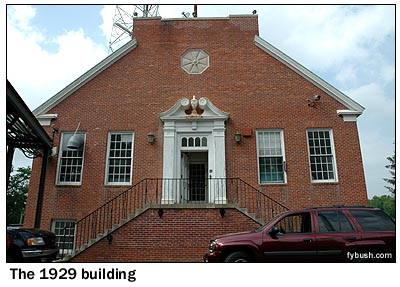
|
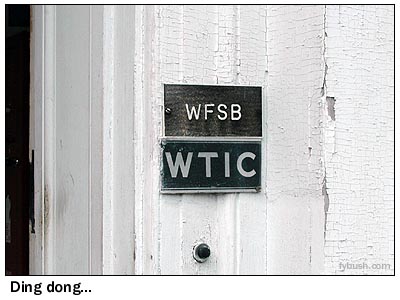
|
We'll go inside soon enough, but first (of course) some history: When the Travelers Insurance Company built this site in 1929, WTIC operated on 1060 kilocycles, sharing time or synched with Baltimore's WBAL, at least when WBAL wasn't operating on 760 kc, synched with New York's WJZ. (It was an interesting time.) The move to Avon transformed WTIC from a 500-watt signal atop a Travelers building on Grove Street in Hartford into one of the country's first 50 kilowatt signals, using a massive RCA transmitter that filled the building.
Travelers added FM service in 1940, under the calls W1XSO. The station moved to commercial operation on 45.3 MHz on December 15, 1941 as W53H, then became WTIC-FM two years later. The move to the 88-108 MHz FM band a few years later sent WTIC-FM to 93.5 (though it never actually used that channel), then to its current 96.5 MHz frequency, where it has operated since 1948.
In 1953, Travelers applied for a TV license, and four years later - September 23, 1957 - WTIC-TV signed on from this site on channel 3. In 1974, the TV station was sold to Post-Newsweek, which renamed channel 3 after executive Franklin S. Beebe - WFSB. (It was sold again, to current owner Meredith, in 1997.)
The radio stations changed hands, too - first to Arnold Chase, and eventually to present owner Infinity. That's where we enter the picture: it's Infinity's Jeff Hugabone, WTIC's chief engineer, who's our tour guide this beautiful Friday afternoon.
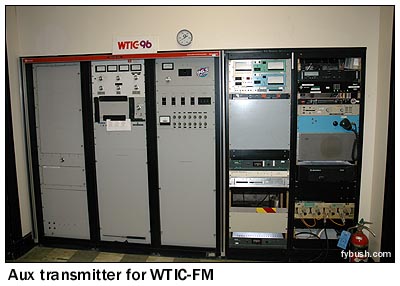
|
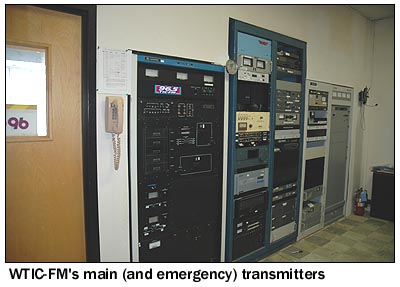
|
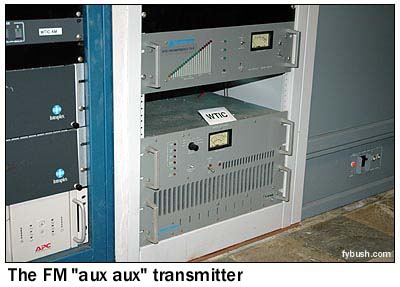 So
in we go, past the front door, into the entry vestibule, and
to the left we enter the WTIC-FM transmitter room. (Had we turned
right, we'd have been in the WFSB transmitter control room.)
WTIC-FM's auxiliary transmitter, a Rockwell Collins 831G-2C,
is on the left; straight ahead is the Harris FM-25K main transmitter,
along with a rack of gear that includes the WTIC STLs and FM
processing.
So
in we go, past the front door, into the entry vestibule, and
to the left we enter the WTIC-FM transmitter room. (Had we turned
right, we'd have been in the WFSB transmitter control room.)
WTIC-FM's auxiliary transmitter, a Rockwell Collins 831G-2C,
is on the left; straight ahead is the Harris FM-25K main transmitter,
along with a rack of gear that includes the WTIC STLs and FM
processing.
To the right of those racks are WTIC's transmitters of last resort: for the FM, that little kilowatt Armstrong shown at left, and for the AM, a Harris Gates Five. Unlike the two main transmitters that we'll see in a moment, which feed the two-tower directional array out back, the Gates Five feeds the TV tower next to the building. It's a neat setup, and we'll explore it in much more detail in part two of our WTIC visit next week.
Heading deeper into the building from this room brings us to our first big surprise. Entering the building and seeing a WFSB door on the right and a WTIC door on the left, we figured that the 1974 split between radio and TV had also meant a division within the transmitter building. (In fact, until we saw the WFSB sign on the door, we'd sort of assumed that channel 3 was in one of the other buildings on the property.)
Not so - for as you exit the WTIC-FM room, you walk right by the WFSB-DT (Channel 33) transmitter and into the big room at the center of the building, where WFSB's Harris transmitter sits right next to WTIC's main transmitter, a Harris DX50, and its aux transmitter, a venerable Continental 317C2. Behold:
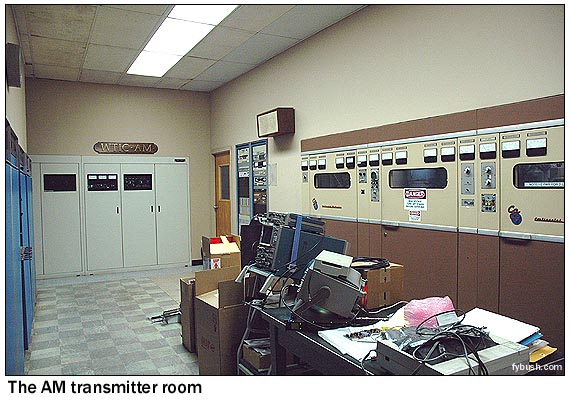
And yes, by the way, there is a matching "WTIC-FM" sign in the FM room, though it's not shown here.
From the vantage point of your humble photographer, behind us is the main entrance to the building, the stairwell that leads down to the basement and up to the attic, and the TV engineering area. Off to the right is an office area for radio engineering, about which we'll have much more to say in part two. And through that door to the right of the DX50 is the phasor, shown below at left. You can be sure that it's a Westinghouse; it went in here in 1957 as part of a rebuild of the facility that also included a Westinghouse transmitter. The earlier phasor had been a mammoth open-air job that was designed to handle 500 kilowatts if the FCC approved it; by 1957, superpower had been pretty well ruled out, and the space was needed for TV.
This phasor comes into play at Dallas sunset, when WTIC switches to directional operation to protect its co-channel partner, KRLD, which is also now an Infinity sister station. WTIC and KRLD have shared a frequency since 1934, when the FCC shifted WTIC from 1060 and sharetime with WBAL to 1040 and a channel shared with KRLD. (The stations moved to 1080 in 1941, of course.)
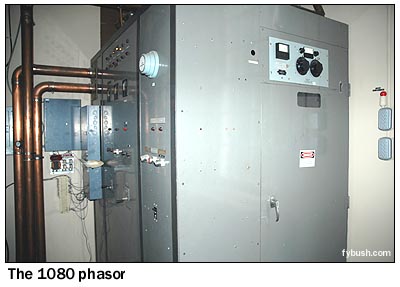
|
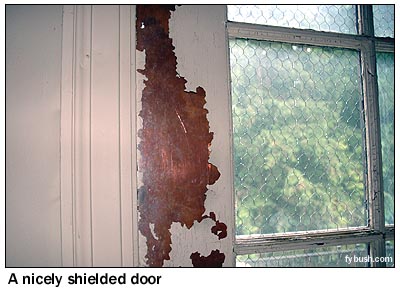
|
Before we head back into the main transmitter room and downstairs, we direct your attention to the door shown above. Thought those old doors were wood? Not so - this plant is extensively lined with copper, and you can see it emerging from behind the paint on the door. (Note also the shielding in the windowpanes.)
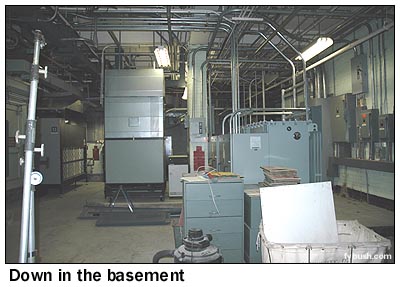
|
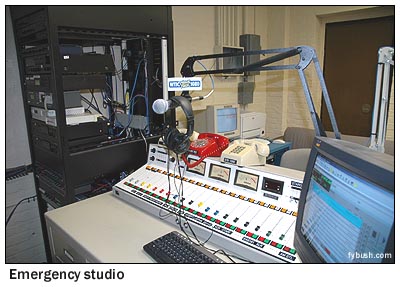
|
The old RCA transmitter, and the Westinghouse that followed it, needed massive power transformers, and as with most transmitter facilities of this vintage, that meant a big basement to house them. With the power transformers now long gone, the space is today filled with power conditioning equipment and some of the facility's HVAC as well.
Underneath the front of the building, Jeff's taken a spare room and built it out as an emergency studio - actually, studios, since the room has the capability to originate separate programming for both AM and FM. It's safe to say there are a fair number of main studios out there that aren't as well equipped as this room, and it's also safe to say that whatever disasters might hit central Connecticut, WTIC is prepared to stay on the air from this facility.
As neat as all this is, we've just scratched the surface. Come back next week as we show you what's hiding in the attic - and examine the steel outside!
JUST RELEASED - it's your very first chance to order the 2006 Tower Site Calendar! Click here for ordering information!
- Previous Site of the Week: WLAT, WCCC/WTMI, Hartford CT
- Next Week: WTIC, Avon CT (part II)
- Site of the Week INDEX!
- How can you help support Site of the Week? Click here!
- Submit your suggestions for a future Site of the Week!
